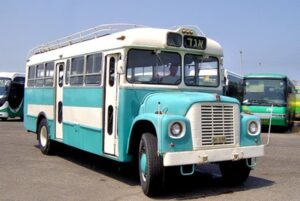It all started in Montreal
I have loved buses all my life. Although I have owned a car since 1973, I take buses in Tel Aviv even on hot and rainy days to prevent the impossible task of finding parking.
My fascination about buses started in Montreal. I loved to hear drivers calling out the station names in English and French. “St James Street; rue St Jacques”. “Rue de la Montagne; Mountain Street”. Even streets with the same name were called out in both languages, like Guy. “Gee; Guy”.
Drivers were exceptionally polite and waited for passengers to sit down. Often, drivers smoked and held their fag outside the bus.
The following sign was posted near the driver in English and French: Safe Driving requires my full attention. Please do not talk to me”. However I used to sit near the driver to see how he handled payment so skillfully, answered questions, and used the clutch. It was also a very good opportunity to listen to French, a language which you cannot learn just in school.
I left Montreal in the 60’s-and each time I have visited since I took a bus. Sadly, no one from my family lives in Montreal anymore. I do not think I will ever take a bus in Montreal again. But I remember each of the four buses I took to McGill University; the 116 or 118, 17, 65 and 4.
I remember once studying a map of all bus routes in Montreal. Once I asked my grandmother to call the bus company to ask which lines were the shortest and longest. She obliged.
Bye bye Montreal. !
!
1968 Israeli Egged and Dan Buses
“Blistering hot” does not clarify the heat on the rear of the bus where passengers board until they pay, after which the conductor lets them pass forward a seat or at least a comfortable place to stand.
The conductor has a button which activates the closing of the rear doors-but after he presses the button, the doors quiver and shake until they slam close, and often a leg or an arm forces the doors to reopen.
With everyone aboard-the conductor rings a bell and the bus lurches forward. Tickets cost 17 agorot (equivalent today to about 5 cents); upon paying you get a ticket but sweaty hands often obliterate it,
Every hour on the hour the driver opens the news and the bus falls quiet. “All planes returned to their bases safely” or bad news, or worse.
Drivers and conductors wore sandals, T shirts and shorts. Talk among passengers was frequent, especially after a new cast.
In Tel Aviv, the bus company was called Dan, because Tel Aviv is the centre of the Dan area. Outside Tel Aviv, all bus drivers owned a share in the bus company, which was (and still is) called “Egged”, band-aid, because it held the state together (Egged is pronounced eh-ged.)
Driving for Egged and Dan was an elite job which paid very well. My late wife’s mother wanted her to marry a “haver egged’ (egged shareholder) so that she would have financial security.
Buses were in very poor repair and very noisy. But like the state itself, they worked, no matter what. The availability public transportation in Israel has always been excellent, with all its frailties.
2024: Cool, Digital and Alienated
Drivers wear uniforms. They are not all as formal as the uniforms on the CTM (Montreal Transport Commission) but standard shirts nevertheless. Many are protected from the public by protective glass.
Buses are modern and air-conditioned. Conductors don’t exist. They have been replaced by “rav kav”, prepaid cards like Octopus Card in Hong Kong or the Nol Card in Dubai. No payment is made on the bus; a rav kav is swiped on a scanner or by swiping a barcode via cellphone when entering…or pretend to scan. Often, older passengers haven’t figured out how the system works, and their cards have not been charged. Drivers don’t care. They drive.
Tourists are often at a loss how to pay. Explanations are hard to come by.
Everyone, including the driver, is yakking or texting on the cellphone. All the time. No one talks to anyone.
Station names are displayed in 3 languages (Hebrew, Arabic and English) on an electric sign board. “The next station is Truman”. “The next station is Allenby”. “The next station is “Balfour”.
Drivers no longer are shareholders. They come from all walks of Israeli society: Arab men and women; new immigrants from Ukraine or Ethiopia; Jewish men and women. Many drive like that are transporting cattle; some are extremely polite and even funny.
One driver on the 567 line asks passengers questions like: “would you like to stop for a coffee”? or “did your grandchildren call you today”? Or, “who are you talking to”? Or, “good morning, professor-don’t be late for class”.
And finally, a story about technology and Israeli buses. The 23 line is a minibus, because it passes thru narrow streets. On the 23, you often hear the following announcement: “some people on this bus have not paid; please swipe your cards to avoid fines”. I asked the driver “what’s the story; we are only 3 passengers and we all paid” “More useless technology” was the reply, in an Amhari accent.




Great reminisce.
Thanks Chuck
The promise of technology bringing us closer together seems to have (widely) missed the mark. Automating the mundane and trivial is nice, but also removes a point of contact with another human. Those points of contacts are what we remember, what influence and shape our day to day. What connect us in our common humanity.
Great hearing your stories and reflections.
So true Thor